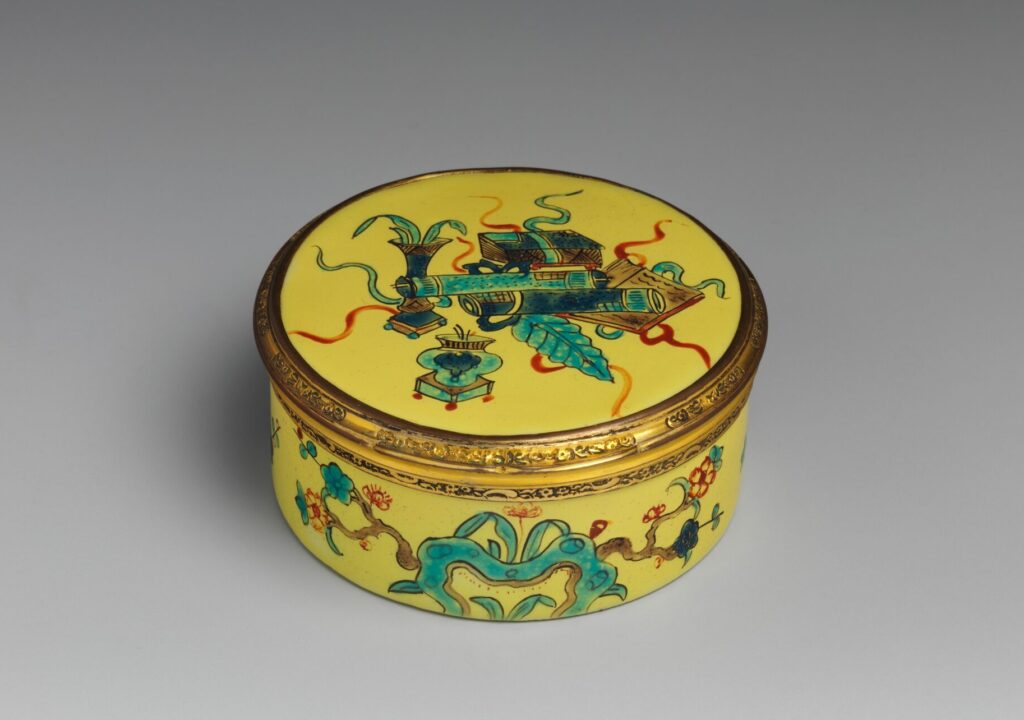The Miniature Rooms of Narcissa Niblack Thorne
The Thorne miniature rooms are the brainchild of Narcissa Thorne, who crafted them between 1932 and 1940 on a 1:12 scale. Incredibly detailed and...
Maya M. Tola 9 January 2025
Decorative snuff boxes were highly ornate containers for powdered tobacco, the consumption of which was a fad that swept the 17th century. By the age of Louis XV, snuff boxes had become particularly fashionable in Paris and London serving both a practical purpose and as a fashionable accessory, showcasing wealth and status, particularly among the upper class.

Snuffbox from Saint-Cloud factory, ca. 18–19th century, Metropolitan Museum of Art, New York City, NY, USA.
Archaeological findings evidence a long history of tobacco use in the Americas dating back tens of thousands of years. The Spanish introduced tobacco to Europe in the 16th century after they observed its usage among the native people of Mesoamerica and South America. By the 17th century, it was cultivated across Africa, the Middle East, and Asia.

Jean Moynat, Gold and platinum snuffbox, ca. 1750–1751, Metropolitan Museum of Art, New York City, NY, USA.
Snuff is a specific form of tobacco consumption involving the inhalation of finely ground tobacco that gained popularity in Europe, particularly in French and Spanish aristocratic circles. The usage of snuff became part of courtly life, and its use developed into a social act in itself.

François Joseph Marteau & Louis Robin, Gold snuffbox, ca. 1743–1744. Walters Art Museum, Baltimore, MD, USA.
Snuff’s powder form and portable nature led to the creation of small containers known as snuffboxes, which became a popular medium for creative display. What started as a practical item evolved into personal adornments and status symbols, embodying the creativity and sophistication of the period.

Jeweled snuffbox, Berlin, Germany, ca. 1765, Metropolitan Museum of Art, New York City, NY, USA.
While the earlier forms of snuffboxes were humble objects crafted from wood, horn, and metal, over time these practical containers transformed into symbols of wealth and refinement. Artisans across France, Germany, England, and Switzerland employed luxurious materials such as gold, enamel, ivory, and porcelain to craft intricate and elegant works of art showcasing remarkable craftsmanship.

Snuffbox in the form of a slipper, Mennecy, France, ca. 1750–1760, Metropolitan Museum of Art, New York City, NY, USA.
The Rococo style had a profound influence on the design of snuffboxes, transforming them into exquisite miniature artworks. Goldsmiths and craftsmen, particularly in Paris, embraced the Rococo aesthetic and adorned snuffboxes with elaborate designs. They incorporated techniques like engraving, repoussé, and enameling to produce luxurious pieces featuring floral patterns, pastoral scenes, and cherubs, frequently rendered in vibrant enamel or set with precious stones.

Snuffbox with landscapes, Meissen Porcelain Manufactory, Germany, ca. 1760, Los Angeles County Museum of Art, Los Angeles, CA, USA.
Miniature portraits, typically featuring loved ones, monarchs, or influential figures gained popularity allowing snuffbox owners to carry these portraits as tokens of loyalty, affection, or status. This further elevated the use of these tobacco containers. Painted with meticulous detail on ivory or enamel, these portraits showcased the skill of miniature artists, who captured lifelike expressions and elaborate costumes within the confines of the box’s lid or interior.

Joseph Etienne Blerzy (design), Nicolas Soret (miniature), Snuffbox with a portrait of Catherine II, ca. 1774–1775 & 1786 (miniature), Metropolitan Museum of Art, New York City, NY, USA.
The rise of industrialization in the 19th century favored mass production, and cigarettes and cigars gradually replaced snuff as the preferred form of tobacco consumption. With this social and economic shift, the demand for snuff and handcrafted artistry diminished and the production of snuffboxes ceased.

Gold and enamel snuffbox, France, ca. 19th century, Metropolitan Museum of Art, New York City, NY, USA.
Snuffboxes are largely relics of a bygone era, appreciated more for their craftsmanship and historical significance than their original function. Snuffboxes are treasured collectible antiques, valued for their artistic merit and as tangible connections to the social customs of the past.
DailyArt Magazine needs your support. Every contribution, however big or small, is very valuable for our future. Thanks to it, we will be able to sustain and grow the Magazine. Thank you for your help!